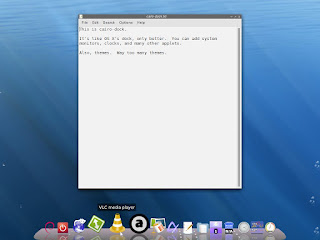On first run, it'll ask you if you want it to launch in OpenGL. I'm not sure PowerPC users can use it in OpenGL given the state of graphics drivers, so I chose "no." This doesn't mean you can't have 3d effects. In fact, you don't need 3d acceleration running, either. You just need a composite manager like xcompmgr (see how to set up xcompmgr here). Otherwise, you may get a black box around it.
As you can see, there are applets in addition to simple launchers such as a clock, cpu meter, bandwidth monitor, desktop switcher, applications menu, and session management for logging out, sleeping, or shutting down. Memory usage is fairly light, and there are several settings available to lighten the cpu load. In fact, in the settings pane if you click the advanced button, you'll find so many options you'll get lost and never be found again.
I tried one other dock, called Docky, and it was okay, but it wasn't as feature-rich as Cairo-Dock and it was a little hard on my cpu. So Cairo-Dock comes out the winner.
EDIT: I forgot to add, to put it in your autostart file, use the command
cairo-dock -c for the cairo backend and cairo-dock -o for the OpenGL backend. And make sure to end the line with an & if it's an Openbox autostart file.EDIT II: As long as we're on the subject of things I forgot, I installed with
sudo aptitude install cairo-dock-core and then sudo aptitude install cairo-dock-plug-ins --without-recommends. I did the --without-recommends part to keep it from installing a bunch of extra stuff I didn't want including the dreaded apt-xapian-index (a package indexer that isn't vital and will bring low end systems to a screeching, and I mean screeching, halt).EDIT III: One more thing and I promise I'll go. Cairo-dock's plug-in package will install
pulseaudio as a dependency. If pulseaudio gives you any problems, I wrote a little about it here.



No comments:
Post a Comment